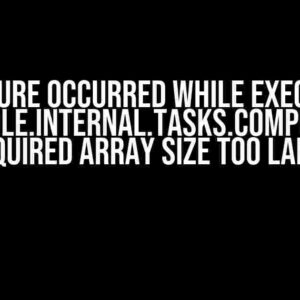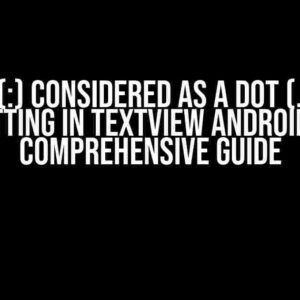Imagine being able to transfer data, send commands, or even control your Android device from your PC seamlessly. Sounds like a futuristic dream, right? Well, it’s not! With USB communication, you can establish a direct connection between your Android app and PC, unlocking a world of possibilities. In this article, we’ll dive into the world of USB communication, exploring how to create a robust connection between your Android app and PC using C#.
What is USB Communication?
USB (Universal Serial Bus) communication is a standard protocol for transferring data between devices. In the context of Android app and PC communication, USB allows for bidirectional data transfer, enabling your app to send and receive data, commands, or even files from your PC.
- Faster Data Transfer**: USB communication enables fast and efficient data transfer between devices.
- Real-time Control**: With USB communication, you can control your Android device in real-time from your PC.
- Reliability**: USB communication is a reliable protocol, minimizing errors and ensuring stable connectivity.
Setting Up the Environment
Before we dive into the code, let’s set up our environment:
Hardware Requirements
- Android device with USB debugging enabled
- PC with USB port
- USB cable
Software Requirements
- Android Studio (for Android app development)
- Visual Studio (for C# PC application development)
- Java Development Kit (JDK) for Android app development
- .NET Framework for C# PC application development
Creating the Android App
In this section, we’ll create a basic Android app that will communicate with our PC application using USB.
Android App Code
<?xml version="1.0" encoding="utf-8"?>
<manifest xmlns:android="http://schemas.android.com/apk/res/android"
package="com.example.usbcommunicationapp">
<uses-permission android:name="android.permission.INTERNET"/>
<uses-permission android:name="android.permission.USB_PERMISSION"/>
<application
android:allowBackup="true"
android:icon="@mipmap/ic_launcher"
android:label="@string/app_name"
android:supportsRtl="true"
android:theme="@style/AppTheme">
<activity android:name=".MainActivity">
<intent-filter>
<action android:name="android.intent.action.MAIN"/>
<category android:name="android.intent.category.LAUNCHER"/>
</intent-filter>
</activity>
</application>
</manifest>
In the above code, we’ve declared the necessary permissions for USB communication and internet access.
public class MainActivity extends AppCompatActivity {
private UsbManager usbManager;
private UsbDevice device;
private UsbInterface usbInterface;
private UsbEndpoint endpoint;
@Override
protected void onCreate(Bundle savedInstanceState) {
super.onCreate(savedInstanceState);
setContentView(R.layout.activity_main);
usbManager = (UsbManager) getSystemService(Context.USB_SERVICE);
}
public void openUSBConnection(View view) {
HashMap<String, UsbDevice> devices = usbManager.getDeviceList();
if (devices.size() > 0) {
device = devices.values().iterator().next();
usbInterface = device.getInterface(0);
endpoint = usbInterface.getEndpoint(0);
usbManager.openDevice(device);
PendingIntent pi = PendingIntent.getBroadcast(this, 0, new Intent(ACTION_USB_PERMISSION), 0);
usbManager.requestPermission(device, pi);
}
}
}
In the above code, we’ve created a `MainActivity` that initializes the USB manager, opens a USB connection, and requests permission for the device.
Creating the PC Application using C#
In this section, we’ll create a PC application using C# that will communicate with our Android app using USB.
PC Application Code
using System;
using System.IO.Ports;
using System.Threading;
namespace USBCommunicationPCApp
{
class Program
{
static SerialPort serialPort;
static void Main(string[] args)
{
serialPort = new SerialPort("COM3", 9600, Parity.None, 8, StopBits.One);
serialPort.Open();
while (true)
{
Console.WriteLine("Enter command: ");
string command = Console.ReadLine();
serialPort.Write(command + "\n");
Thread.Sleep(1000);
}
}
}
}
In the above code, we’ve created a C# console application that initializes a serial port connection using the `SerialPort` class. We’re using the `COM3` port, but you’ll need to adjust this according to your system’s settings.
Establishing USB Communication
In this section, we’ll establish a USB communication connection between our Android app and PC application.
Android App Code
public void sendDataToPC(View view) {
byte[] data = "Hello from Android!".getBytes();
usbManager.bulkTransfer(endpoint, data, data.length, 5000);
}
In the above code, we’ve created a method that sends a byte array to the PC application using the `bulkTransfer` method.
PC Application Code
static void Main(string[] args)
{
// ...
while (true)
{
// ...
string response = serialPort.ReadLine();
Console.WriteLine("Response from Android: " + response);
Thread.Sleep(1000);
}
}
In the above code, we’ve added code to read the response from the Android app using the `ReadLine` method and display it in the console.
Testing the USB Communication
Now that we’ve established the USB communication connection, let’s test it.
Android App
- Run the Android app on your device.
- Click the “Open USB Connection” button to establish a connection with your PC.
- Click the “Send Data to PC” button to send a message to your PC.
PC Application
- Run the PC application on your PC.
- Open the Command Prompt or Terminal and navigate to the PC application’s directory.
- Type a command (e.g., “Hello from PC!”) and press Enter.
- The response from the Android app should be displayed in the console.
Conclusion
And that’s it! You’ve successfully established a USB communication connection between your Android app and PC application using C#. With this connection, you can transfer data, send commands, or even control your Android device from your PC.
Next Steps
- Experiment with different communication protocols (e.g., HTTP, Bluetooth, Wi-Fi).
- Explore advanced USB communication topics (e.g., USB host mode, USB device mode).
- Integrate USB communication into your existing Android app or PC application.
Remember, the possibilities are endless when it comes to USB communication between Android app and PC. Unlock the full potential of your devices and take your projects to the next level!
| Keyword | Definition |
|---|---|
| USB Communication | A standard protocol for transferring data between devices. |
| Android App | A mobile application developed using Android Studio. |
| PC Application | A desktop application developed using C# and Visual Studio. |
| SerialPort | A .NET Framework class for communicating with serial devices. |
Frequently Asked Question
Got questions about USB communication between Android app and PC using C#? We’ve got answers!
How do I establish a USB connection between my Android app and PC using C#?
To establish a USB connection, you’ll need to use the Android USB API and the .NET USB library in C#. First, set up your Android device as a USB accessory, then use the Android USB API to communicate with the device. On the PC side, use the .NET USB library to detect and connect to the device. Finally, use the Serial USB communication protocol to send and receive data between the app and the PC.
What are the essential C# libraries required for USB communication?
You’ll need the following C# libraries: USB.NET, USBSerial, and Microsoft.NET.Sdk.WindowsDesktop. These libraries will help you interact with the USB device, establish a serial connection, and perform read and write operations.
Can I use C# to read and write data to the Android device’s file system?
Yes, you can use C# to read and write data to the Android device’s file system using the USB communication protocol. You’ll need to use the Android USB API to request permission to access the file system, then use the .NET USB library to send and receive file data.
How do I handle USB communication errors and exceptions in C#?
To handle USB communication errors and exceptions in C#, use try-catch blocks to catch and handle exceptions such as timeouts, device not found, and connection errors. You can also use the USB library’s built-in error handling mechanisms, such as the ErrorReceived event, to detect and respond to errors.
Is it possible to use C# to communicate with multiple Android devices connected to the same PC?
Yes, it is possible to use C# to communicate with multiple Android devices connected to the same PC. You’ll need to use the USB library to detect and connect to each device, then use separate threads or tasks to communicate with each device concurrently. Be sure to use synchronization mechanisms to prevent data collisions and ensure reliable communication.



